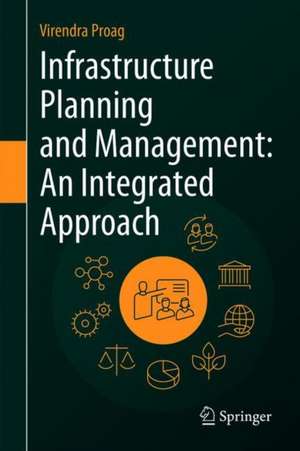Infrastructure Planning and Management: An Integrated Approach
Autor Virendra Proagen Limba Engleză Hardback – 6 noi 2020
This book is intended for graduates and practising professionals who are involved in the general development planning of their country/region. It enables better understanding, collaboration and communication with other professionals in relation to their own or different disciplines.
Preț: 729.20 lei
Preț vechi: 857.88 lei
-15% Nou
Puncte Express: 1094
Preț estimativ în valută:
139.55€ • 144.81$ • 116.64£
139.55€ • 144.81$ • 116.64£
Carte disponibilă
Livrare economică 24 februarie-10 martie
Preluare comenzi: 021 569.72.76
Specificații
ISBN-13: 9783030485580
ISBN-10: 3030485587
Pagini: 683
Ilustrații: XXXII, 683 p. 111 illus., 31 illus. in color. With online files/update.
Dimensiuni: 155 x 235 mm
Greutate: 1.32 kg
Ediția:1st ed. 2021
Editura: Springer International Publishing
Colecția Springer
Locul publicării:Cham, Switzerland
ISBN-10: 3030485587
Pagini: 683
Ilustrații: XXXII, 683 p. 111 illus., 31 illus. in color. With online files/update.
Dimensiuni: 155 x 235 mm
Greutate: 1.32 kg
Ediția:1st ed. 2021
Editura: Springer International Publishing
Colecția Springer
Locul publicării:Cham, Switzerland
Cuprins
Part I. Chapter 1: Introduction to Infrastructure.- Chapter 2: Infrastructure and Economic Growth.- 3. Chapter 3: Infrastructure Vision for SD.- 4. Chapter 4: Infrastructure and Spatial Organisation.- 5. Chapter 5: Infrastructure as a System.- 6. Chapter 6: The Long Term Plan for Infrastructure.- 7. Part II. Chapter 7: Economic and Social Aspects of Infrastructure.- 8. Chapter 8: Infrastructure as Public or Private Goods.- 9. Chapter 9: Multi Sector/Purpose Infrastructure Planning.- 10. Chapter 10: Climate Change and Infrastructure.- 11. Chapter 11: Infrastructure Resilience.- 12. Chapter 12: Disaster Recovery and Management.- 13. Chapter 13: Analysis of Environmental Impacts of Infrastructure.- 14. Chapter 14: Modelling In Infrastructure Planning.- 15. Part III. Chapter 15: Quality and Reliability of Infrastructure.- 16. Chapter 16: Decision Taking With Infrastructure.- 17. Chapter 17: Multi Objective Evaluation Criteria for Infrastructure.- 18. Part IV. Chapter 18: Cost Allocation for Infrastructure Implementation.- 19. Chapter 19: Human Resources Management for Infrastructure.- 20. Chapter 20: Infrastructure Markets and the Private Sector.- 21. Chapter 21: Quality of Infrastructure Service Delivery.- 22. Chapter 22: Infrastructure Implementation.
Notă biografică
After graduating in civil engineering, Dr. Proag obtained his Ph.D from l’Ecole Nationale Supérieure des Mines de Paris. During his 15 years in the water sector, he has been involved in the preparation of feasibility studies, the design and supervision of pipelines and other schemes relating to construction and repair of minor dams, or harnessing water sources either through run-of-river schemes or from boreholes and in the preparation of a Master Plan for Water Resources for Mauritius. He subsequently joined the University of Mauritius, where he has been lecturing, for more than 20 years, generally on civil engineering and management subjects, and infrastructure planning and management, where he has trained many people to consider infrastructure as a whole, together with a need for resilience towards extreme conditions.
Textul de pe ultima copertă
This book explains how water, electricity/power and roads are linked together within the general basket of development and how to obtain the optimum use of resources. The emphasis, nowadays, is on multipurpose activities, optimum use of resources, environmental approach, minimum use of energy. This book tries to integrate all of these, by showing the links between the different components of infrastructure and trying to model them. A very good design may fail during the implementation or operation because of bad design, but also due to inadequate attention given to the human aspects required for its operation.
This book is intended for graduates or practicing professionals who are involved in the general development planning of their country/region. It creates a general awareness about what is needed to communicate with other professionals in terms of their own fields and others.
Caracteristici
Includes problems and worked examples Offers information specially adapted to small island problems Explains the need for long term infrastructure planning Considers infrastructure resilience against extreme conditions Works out cost allocation for multipurpose projects Describes the need for infrastructure maintenance
